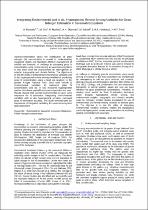 ResearchSpace
ResearchSpace
Integrating environmental and in situ hyperspectral remote sensing variables for grass nitrogen estimation in savannah ecosystems
JavaScript is disabled for your browser. Some features of this site may not work without it.
- ResearchSpace
- →
- Research Publications/Outputs
- →
- Conference Publications
- →
- View Item
| dc.contributor.author |
Ramoelo, Abel

|
|
| dc.contributor.author |
Cho, Moses A

|
|
| dc.contributor.author |
Mathieu, Renaud SA

|
|
| dc.contributor.author |
Skidmore, AK

|
|
| dc.contributor.author |
Schlerf, M

|
|
| dc.contributor.author |
Heitkonig, IMA

|
|
| dc.contributor.author |
Prins, HHT

|
|
| dc.date.accessioned | 2011-05-17T09:38:56Z | |
| dc.date.available | 2011-05-17T09:38:56Z | |
| dc.date.issued | 2011-04 | |
| dc.identifier.citation | Ramoelo, A., Cho, M.A., Mathieu, R. et al. 2011. Integrating environmental and in situ hyperspectral remote sensing variables for grass nitrogen estimation in savannah ecosystems. The International Symposium on Remote Sensing of Environment (ISRSE 2011)-34th ISRSE, Sydney, Australia, 10-15 April 2011 | en_US |
| dc.identifier.uri | http://hdl.handle.net/10204/5004 | |
| dc.description | The International Symposium on Remote Sensing of Environment (ISRSE 2011)-34th ISRSE, Sydney, Australia, 10-15 April 2011 | en_US |
| dc.description.abstract | Information about the distribution of grass nitrogen (N) concentration is crucial in understanding rangeland vitality and facilitates effective management of wildlife and livestock. A challenge in estimating grass N concentration using remote sensing in savannah ecosystems is that these areas are characterised by heterogeneity in edaphic, topographic and climatic factors. The objective is to test the utility of integrating environmental variables and in situ hyperspectral remote sensing variables for predicting grass N concentration along a land use gradient in the greater Kruger National Park. Data used include i) environmental variables, ii) measured grass N concentration and iii) in situ measured hyperspectral spectra. Non-linear partial least square regression was used. Results showed that several environmental variables were important for N estimation. Integrating environmental variables with in situ hyperspectral variables increased grass N estimation accuracy. The study demonstrated the importance of integrated modelling for savannah ecosystem state assessment. | en_US |
| dc.language.iso | en | en_US |
| dc.relation.ispartofseries | Workflow request;6483 | |
| dc.subject | Hyperspectral | en_US |
| dc.subject | Savannah ecosystems | en_US |
| dc.subject | Foliar nitrogen concentration | en_US |
| dc.subject | Grass nitrogen (N) | en_US |
| dc.subject | Wildlife management | en_US |
| dc.subject | Livestock management | en_US |
| dc.subject | Kruger National Park | en_US |
| dc.subject | Environmental remote sensing | en_US |
| dc.subject | Remote sensing variables | en_US |
| dc.subject | Rangeland vitality | en_US |
| dc.title | Integrating environmental and in situ hyperspectral remote sensing variables for grass nitrogen estimation in savannah ecosystems | en_US |
| dc.type | Conference Presentation | en_US |
| dc.identifier.apacitation | Ramoelo, A., Cho, M. A., Mathieu, R. S., Skidmore, A., Schlerf, M., Heitkonig, I., & Prins, H. (2011). Integrating environmental and in situ hyperspectral remote sensing variables for grass nitrogen estimation in savannah ecosystems. http://hdl.handle.net/10204/5004 | en_ZA |
| dc.identifier.chicagocitation | Ramoelo, Abel, Moses A Cho, Renaud SA Mathieu, AK Skidmore, M Schlerf, IMA Heitkonig, and HHT Prins. "Integrating environmental and in situ hyperspectral remote sensing variables for grass nitrogen estimation in savannah ecosystems." (2011): http://hdl.handle.net/10204/5004 | en_ZA |
| dc.identifier.vancouvercitation | Ramoelo A, Cho MA, Mathieu RS, Skidmore A, Schlerf M, Heitkonig I, et al, Integrating environmental and in situ hyperspectral remote sensing variables for grass nitrogen estimation in savannah ecosystems; 2011. http://hdl.handle.net/10204/5004 . | en_ZA |
| dc.identifier.ris | TY - Conference Presentation AU - Ramoelo, Abel AU - Cho, Moses A AU - Mathieu, Renaud SA AU - Skidmore, AK AU - Schlerf, M AU - Heitkonig, IMA AU - Prins, HHT AB - Information about the distribution of grass nitrogen (N) concentration is crucial in understanding rangeland vitality and facilitates effective management of wildlife and livestock. A challenge in estimating grass N concentration using remote sensing in savannah ecosystems is that these areas are characterised by heterogeneity in edaphic, topographic and climatic factors. The objective is to test the utility of integrating environmental variables and in situ hyperspectral remote sensing variables for predicting grass N concentration along a land use gradient in the greater Kruger National Park. Data used include i) environmental variables, ii) measured grass N concentration and iii) in situ measured hyperspectral spectra. Non-linear partial least square regression was used. Results showed that several environmental variables were important for N estimation. Integrating environmental variables with in situ hyperspectral variables increased grass N estimation accuracy. The study demonstrated the importance of integrated modelling for savannah ecosystem state assessment. DA - 2011-04 DB - ResearchSpace DP - CSIR KW - Hyperspectral KW - Savannah ecosystems KW - Foliar nitrogen concentration KW - Grass nitrogen (N) KW - Wildlife management KW - Livestock management KW - Kruger National Park KW - Environmental remote sensing KW - Remote sensing variables KW - Rangeland vitality LK - https://researchspace.csir.co.za PY - 2011 T1 - Integrating environmental and in situ hyperspectral remote sensing variables for grass nitrogen estimation in savannah ecosystems TI - Integrating environmental and in situ hyperspectral remote sensing variables for grass nitrogen estimation in savannah ecosystems UR - http://hdl.handle.net/10204/5004 ER - | en_ZA |





